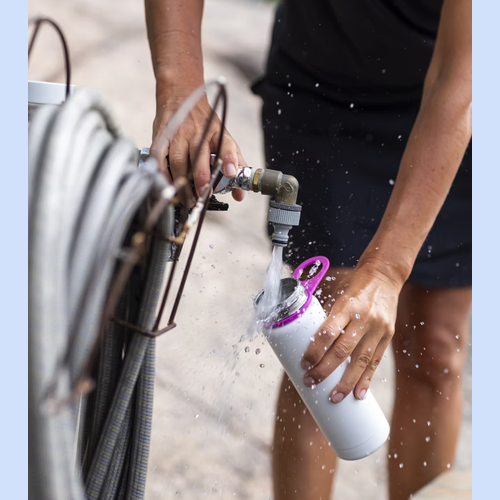
Municipalities are making great efforts every day to produce quality drinking water. However, once distributed, this water is exposed to a risk of contamination. Municipalities can implement concrete means to protect themselves against it such as the implementation of a cross-connection control program and the application of clear regulations.
The presence of unprotected cross-connections in a building's plumbing system can result in pollutants coming into direct contact with the drinking water. Contamination may be limited to the building concerned, but it could also, in the worst-case scenario, join the water supply network and spread to neighboring buildings. The consequences of contamination on public health depend on the nature of the contaminant. The risk is very real and that is why, in Quebec, we must follow strict regulations.
One of the main causes of contamination is backflow which is a reversal of the direction of water flow. This phenomenon occurs mainly because of large fluctuations in pressure in the plumbing network. Some buildings are at a higher risk of experiencing these fluctuations. They include high-rise buildings and those that require a large supply of water to operate certain applications.
The applications that generate cross-connections are numerous and present a level of risk ranging from low to high. For example, irrigation, fire protection and glycol heating systems are common applications that must be adequately protected. Another example of an application that can be contaminated is a chemical dispenser connected to a building's drinking water system.
When not protected, cross-connections are more vulnerable in the event of backflow. The installation of a backflow prevention device at strategic locations on the plumbing system is an effective protection against contamination.
La protection des raccordements croisés est obligatoire dans l’ensemble du Canada. Dans les autres provinces canadiennes, chacune des municipalités est responsable d’adopter sa propre réglementation. Au Québec, la Régie du bâtiment (RBQ) applique la Loi sur le bâtiment : composée du Code de construction et du Code de sécurité, cette loi encadre autant les constructions neuves que les bâtiments existants.
Le chapitre III (Plomberie) du Code de construction, qui s’applique aux constructions neuves, impose aux entrepreneurs en plomberie des règles pour empêcher toute forme de contamination du réseau d’eau potable. De leur côté, les propriétaires de bâtiments existants trouveront les dispositions relatives à la protection des raccordements croisés dans le Code de sécurité (chapitre I, article 7).
Seuls les bâtiments existants totalement résidentiels de moins de neuf logements ou de moins de trois étages ne sont pas assujettis au Code de sécurité. Tous les autres édifices industriels, commerciaux ou institutionnels (ICI) sont concernés.
La Loi sur le bâtiment s’appuie sur deux normes CSA : B64.10-11 (Sélection et installation des dispositifs antirefoulement) et B64.10.1-11 (Entretien et mise à l’essai à pied d’œuvre des dispositifs antirefoulement).
Des inspecteurs de la RBQ sillonnent le Québec. Si un propriétaire ou un entrepreneur est pris en défaut, il devra démontrer qu’il prend les mesures nécessaires pour corriger la situation dans un délai jugé raisonnable. Cela dit, les inspecteurs ne suffisent pas à la tâche. C’est pourquoi l’implication des municipalités est essentielle.
It is desirable that each city adopt its own legislation to encourage building owners affected by the Act to comply with it. Of course, municipal buildings must also be rigorously protected to set an example.
Some municipalities in Western Canada that are ahead of Quebec in this area, have adopted clear regulations on the subject. Despite this, inspectors still encounter negligent owners. Yet, when public health is compromised, the best protection would certainly be to close the drinking water supply to a building, while it is brought up to standard... Obviously, a huge step is to be taken before we come to applying such a coercive measure!
We must, therefore, give priority to collaboration between a city and the owners of the buildings located within its territory. Rewarding owners whose buildings are compliant and who implement a cross-connection control program can have a positive impact, depending on the incentives put in place.
Both cities and building owners can benefit from a cross-connection control program, the aim of which is to secure connections at risk. Although the implementation of such a program may seem a colossal task, depending on the complexity of the building, it nevertheless provides a tangible guarantee against possible contamination of drinking water.
Cities have a huge responsibility to their inhabitants, as do the owners of buildings subject to the Act. In the presence of such a risk, however, minimal it may be, prevention comes at a much lower cost!
We use cookies to understand how you use our site and to improve your experience. This includes personalizing content and advertising. By continuing to use our site, you accept our use of cookies, terms and conditions, privacy policy. Confused? Send us an e-mail.
I acceptWe use cookies
Respecting your privacy matters to us. We use cookies to personalize our content and facilitate your digital experience. Some cookies may be collected with your consent.
Essential
Essential cookies help make a website usable by enabling basic functions such as page navigation and access to secure areas of the website. The website cannot function properly without these cookies.
Performance
These cookies enable us to analyze navigation on our sites and improve their operation.
Customization
Preference cookies enable a website to remember information that modifies the behavior or appearance of the site, such as your preferred language or the region you are in.
Targeted advertising
These cookies help us limit the number of times you see an advertisement, personalize our offers and services according to your centers of interest, measure the effectiveness of an advertising campaign, and so on. They may be shared with our partners.
We use cookies
Respecting your privacy matters to us. We use cookies to personalize our content and facilitate your digital experience. Some cookies may be collected with your consent.